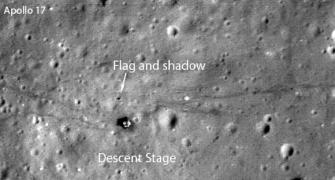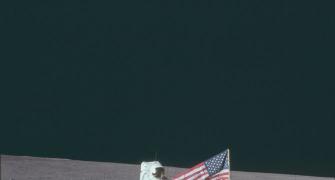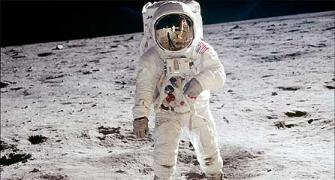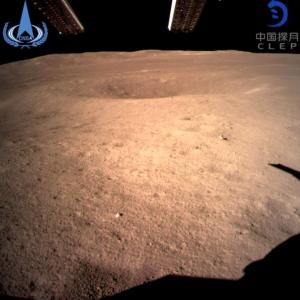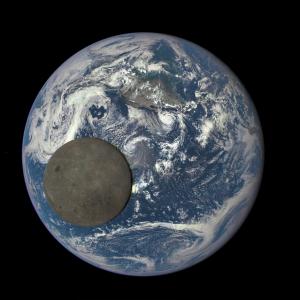"That's one small step for man, one giant leap for mankind."
Fifty years ago on July 20, 1969 with these words American astronauts Neil Armstrong, Michael Collins, and Edwin "Buzz" E Aldrin made history by becoming the first human beings to set foot on another world -- the moon.
It was an event that was watched by millions on television and one that remains etched in all our memories.
Collected here are 17 images of that historic mission, a "giant leap for mankind".

Apollo 11 astronaut Neil Armstrong waves to well wishers on the way out to the transfer van on July 16, 1969. Mike Collins, Buzz Aldrin and Deke Slayton (dark shirt behind Aldrin to the left) follow Armstrong down the hallway. The plan to send a human in space began back in 1961 when then United States President President John F Kennedy called upon his vice president Lyndon Johnson to beat the Soviets in space. It was then that VP Johnson reached out to the godfather of NASA's space program: Wernher von Braun. Photograph: NASA/Handout/Reuters

The Apollo 11 Saturn V lifts off with astronauts Neil A Armstrong, Michael Collins and Edwin E Aldrin Jr from Kennedy's Launch Complex 39A at 9:32 am EDT on July 16, 1969. Between October 1968 and May 1969, four preparatory Apollo missions were launched. Armstrong was chosen in December 1968 to command the eleventh. Photograph: NASA/Handout/Reuters

Astronaut Edwin E Aldrin Jr, lunar module pilot, is pictured in the Apollo 11 Lunar Module during the lunar landing mission in this July 20, 1969 photo. This picture was taken by Astronaut Neil A Armstrong, commander, prior to the moon landing. Photograph: NASA/Handout/Reuters

Space communicators and astronauts Charles Duke, James Lovell and Fred Haise (left to right) stay in contact with the Apollo 11 astronauts during their lunar landing mission at mission control in Houston, Texas. The first four days of Apollo 11's journey to the Moon had gone according to plan, but just twenty minutes before landing, the atmosphere grew tense as the crew encountered a series of problems. Photograph: NASA/Handout/Reuters

Once they successfully landed on the moon, astronaut Neil Armstrong was the first to set foot on the lunar surface. Interestingly, months before the launch, Armstrong had told Aldrin he was pulling rank and would be the first to set foot on the lunar surface. As he did so, he uttered his famous words, 'That's one small step for man, a giant leap for mankind.' It was after this that Armstrong captured this image of his shadow on the moon. Photograph: NASA/Handout/Reuters

Apollo 11 astronaut Edwin 'Buzz' Aldrin deploys a scientific experiment package on the surface of the moon. In the background is the Lunar Module, as is a flag of the United States. It was 20 minutes after Armstrong stepped down that Aldrin followed. "Beautiful, beautiful, beautiful," he said. "A magnificent desolation." Photograph: Neil Armstrong/NASA/Getty Images

Buzz Aldrin, lunar module pilot for Apollo 11, poses for a photograph beside the deployed United States flag during an extravehicular activity on the moon. Mission control granted them extra time on the lunar surface. Armstrong was given 15 extra minutes, Aldrin 12. Photograph: Neil Armstrong/NASA/Handout/Reuters

Part of Buzz Aldrin's leg, foot and footprint on the surface of the moon during the Apollo 11 lunar mission. In his 2009 book, Buzz Aldrin wrote about his time on the moon, "I started jogging around a bit, and it felt like I was moving in slow motion in a lazy lope, often with both of my feet floating in the air." And does the moon look like, up close? Its colour varies with the angle of the Sun: from brown to grey to black as coal. And the lower level of gravity takes getting used to. Photograph: Keystone/Getty Images

As the astronauts landed on the lunar surface, flight controllers celebrated their success at the Mission Operations Control Room at the Johnson Space Center. Photograph: NASA/Handout/Reuters

US President Richard Nixon watches the Apollo 11 moon landing on television and speaks to the astronauts live on national television from the Oval Office in the White House. The call from the White House was relayed by Mission Control to the astronauts via the Manned Space Flight Network antennas positioned around the world. The US had finally outraced the Soviets in the space race. Photograph: Oliver F Atkins/White House/US National Archives and Records

Apollo 11 astronauts Neil Armstrong (left), Michael Collins and Buzz Aldrin smile through the window of the mobile quarantine van on July 24, 1969. After spending a total of two-and-a-half hours -- picking up piles of Moon rocks and taking photos, installing scientific instruments and planting the US flag, the astronauts made their way back home. On July 24, the astronauts entered the atmosphere and splashed down safely into the Pacific. Photograph: NASA/Handout/Reuters

After returning to Earth, the Apollo 11 crew jokingly filled out this customs and immigration form, dated July 24, 1969, declaring cargo of "moon rock and moon dust samples" and responding to questions of carrying disease: "to be determined." Photograph: NASA/Department of Homeland Security/Reuters

A close-up view of the lunar rocks collected by the astronauts during the Apollo 11 mission. The rock box was opened for the first time in the Vacuum Laboratory of the Manned Spacecraft Center's Lunar Receiving Laboratory, on August 5, 1969. Photograph: NASA/Handout/Reuters

After landing, the three crew members were reunited with their wives at Ellington Air Force Base near Houston in Texas on July 27. From left to right, astronauts Neil A Armstrong, Edwin E 'Buzz' Aldrin Jr and Michael Collins and their wives (left to right) Pat Collins, Jan Armstrong and Joan Aldrin. At their first press conference, three weeks later, reporters asked the three men, now global heroes, whether they would ever consider returning to the Moon. "In the Lunar Receiving Laboratory, we had very little time for meditation," replied Armstrong. Photograph: Space Frontiers/Getty Images

Apollo 11 lunar module pilot Buzz Aldrin, command module pilot Michael Collins and commander Neil Armstrong, seen in the lead car are showered in ticker tape during a parade down Broadway and Park Avenue in New York City. Photograph: Bill Taub/NASA/Handout/Reuters

People celebrate as the Apollo 11 crew proceeds down Broadway and Park Avenue in a ticker tape parade in New York City. Interestingly, none of them ever went back into space ever again. Photograph: NASA/Handout/Reuters


